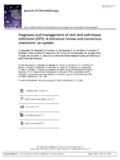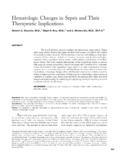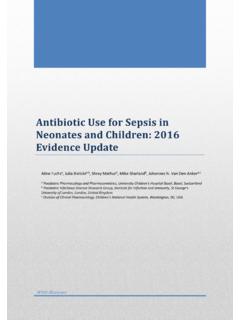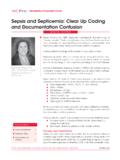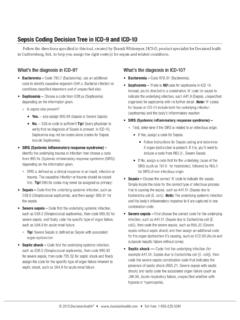Transcription of Research OriginalInvestigation ...
1 Copyright 2016 American Medical Association. All rights of Clinical Criteria for SepsisFor the Third International Consensus Definitionsfor sepsis and Septic Shock ( sepsis -3)Christopher W. Seymour, MD, MSc; Vincent X. Liu, MD, MSc; Theodore J. Iwashyna, MD, PhD; Frank M. Brunkhorst, MD; Thomas D. Rea, MD, MPH;Andr Scherag, PhD; Gordon Rubenfeld, MD, MSc; Jeremy M. Kahn, MD, MSc; Manu Shankar-Hari, MD, MSc; Mervyn Singer, MD, FRCP;Clifford S. Deutschman, MD, MS; Gabriel J. Escobar, MD; Derek C. Angus, MD, MPHIMPORTANCEThe Third International Consensus Definitions Task Force defined sepsisas life-threatening organ dysfunction due to a dysregulated host response to infection. The performance of clinical criteria for this sepsis definition is evaluate the validity of clinical criteria to identify patients with suspectedinfection who are at risk of , SETTINGS, AND POPULATIONA mong million electronic health record encountersfrom January 1, 2010, to December 31, 2012, at 12 hospitals in southwestern Pennsylvania, weidentified those with suspected infection in whom to compare criteria.
2 Confirmatory analyseswere performed in 4 data sets of 706 399 out-of-hospital and hospital encounters at 165 USand non-US hospitals ranging from January 1, 2008, until December 31, [ sepsis -related] Organ Failure Assessment (SOFA) score, systemicinflammatory response syndrome (SIRS) criteria, Logistic Organ Dysfunction System (LODS)score, and a new model derived using multivariable logistic regression in a split sample, the quickSequential [ sepsis -related] Organ Failure Assessment (qSOFA) score (range, 0-3 points, with 1point each for systolic hypotension [ 100 mm Hg], tachypnea [ 22/min], or altered mentation).MAIN OUTCOMES AND MEASURESFor construct validity, pairwise agreement was predictive validity, the discrimination for outcomes (primary: in-hospital mortality;secondary: in-hospital mortality or intensive care unit [ICU] length of stay 3 days) morecommon in sepsis than uncomplicated infection was determined.
3 Results were expressed asthe fold change in outcome over deciles of baseline risk of death and area under the receiveroperating characteristic curve (AUROC).RESULTSIn the primary cohort, 148 907 encounters had suspected infection (n = 74 453derivation; n = 74 454 validation), of whom 6347 (4%) died. Among ICU encounters in thevalidation cohort (n = 7932 with suspected infection, of whom 1289 [16%] died), the predictivevalidity for in-hospital mortality was lower for SIRS (AUROC = ; 95% CI, ) andqSOFA (AUROC = ; 95% CI, ) vs SOFA (AUROC = ; 95% CI, ;P< .001 for both) or LODS (AUROC = ; 95% CI, ;P< .001 for both). Amongnon-ICU encounters in the validation cohort (n = 66 522 with suspected infection, of whom1886 [3%] died), qSOFA had predictive validity (AUROC = ; 95% CI, ) that wasgreater than SOFA (AUROC = ; 95% CI, ;P< .001) and SIRS (AUROC = ; 95%CI, ;P< .001). Relative to qSOFA scores lower than 2, encounters with qSOFA scores of2 or higher had a 3- to 14-fold increase in hospital mortality across baseline risk deciles.
4 Findingswere similar in external data sets and for the secondary AND RELEVANCEA mong ICU encounters with suspected infection, thepredictive validity for in-hospital mortality of SOFA was not significantly different than themore complex LODS but was statistically greater than SIRS and qSOFA, supporting its use inclinical criteria for sepsis . Among encounters with suspected infection outside of the ICU, thepredictive validity for in-hospital mortality of qSOFA was statistically greater than SOFA andSIRS, supporting its use as a prompt to consider possible 2016;315(8):762-774. 757 Author Audio articlespages 775and801 Supplemental Affiliations:Authoraffiliations are listed at the end of Author:ChristopherW. Seymour, MD, MSc, Departmentsof Critical Care Medicine andEmergency Medicine, University ofPittsburgh School of Medicine,Clinical Research , Investigation, andSystems Modeling of Acute Illness(CRISMA) Center, 3550 Terrace St,Scaife Hall, Ste 639, Pittsburgh, PA15261 Investigation|CARING FOR THE CRITICALLY ILL PATIENT762(Reprinted) 2016 American Medical Association.
5 All rights From: by a Bib IRCCS Ist. Naz. Ricerca sul Cancro - Genova User on 04/20/2016 Copyright 2016 American Medical Association. All rights common and associated with high morbidityand mortality,1,2sepsis and related terms remain diffi-cult to define. Two international consensus confer-ences in 1991 and 2001 used expert opinion to generate the cur-rent ,4 However,advances in the understanding ofthe pathobiology and appreciation that elements of the defini-tions may be outdated, inaccurate, or confusing promptedthe European Society ofIntensive Care Medicineand the Society of CriticalCare Medicine to convenea Third International Con-sensus Task Force to re-examine the many syndromes,there is no gold stan-dard diagnostic test forsepsis. Therefore, the taskforce chose several meth-ods to evaluate the useful-ness of candidate clinical criteria, including clarity, reliability(consistency and availability), content validity (biologic ratio-nale and face validity), construct validity (agreement betweensimilar measures), criterion validity (correlation with estab-lished measures and outcomes), burden, and timeliness.
6 Un-like prior efforts, the task force used systematic literature re-views and empirical data analyses to complement on clarity and content validity and after literaturereview and expert deliberation, the task force recommendedelimination of the termssepsis syndrome,septicemia, andse-vere sepsisand instead defined sepsis as life-threatening or-gan dysfunction due to a dysregulated host response toinfection. 5Of note, the task force did not attempt to redefineinfection. Rather, it next sought to generate recommenda-tions for clinical criteria that could be used to identify sepsisamong patients with suspected or confirmed infection. Thepurpose of this study was to inform this step by analyzing datafrom several large hospital databases to explore the constructvalidity and criterion validity of existing and novel criteria as-sociated with study was approved with waiver of informed consent bythe institutional review boards of the University of Pittsburgh,Kaiser Permanente Northern California (KPNC), Veterans Ad-ministration (VA) Ann Arbor Health System, Washington StateDepartment of Health, King County Emergency Medical Ser-vices (KCEMS), University of Washington, and Jena Design, Setting, and PopulationA retrospective cohort study was performed among adult en-counters (age 18 years) with suspected infection.
7 The pri-mary cohort was all hospital encounters from 2010 to 2012 at12 community and academic hospitals in the UPMC health caresystem in southwestern Pennsylvania. The cohort included allmedical and surgical encounters in the emergency depart-ment, hospital ward, and intensive care unit (ICU). We cre-ated a random split sample (50/50) from the UPMC cohort, thederivation cohort for developing new criteria, and the valida-tion cohort for assessment of new and existing also studied 4 external data sets: (1) all inpatientencounters at 20 KPNC hospitals from 2009 to 2013; (2) all en-counters in 130 hospitals in the United States VA systemfrom 2008 to 2010; (3) all nontrauma, nonarrest emergencymedical services records from 5 advanced life support agen-cies from 2009-2010 transported to 14 hospitals with commu-nity infection in King County, Washington (KCEMS)6; and (4) allpatients from 2011-2012 at 1 German hospital enrolled withhospital-acquired infection in the ALERTS prospective cohorts were selected because they included pa-tient encounters from different phases of acute care (out of hos-pital, emergency department, hospital ward) and countries(United States and Germany) with different types of infection(community and nosocomial).
8 The UPMC, KPNC, and VA datawere obtained from the electronic health records (EHRs) of therespective health systems; KCEMS data were obtained from theadministrative out-of-hospital record; and ALERTS data werecollected prospectively by Research a Cohort With Suspected InfectionFor EHR data (UPMC, KPNC, and VA), the first episode of sus-pected infection was identified as the combination of antibiot-ics (oral or parenteral) and body fluid cultures (blood, urine, ce-rebrospinal fluid, etc). We required the combination of cultureand antibiotic start time to occur within a specific time the antibiotic was given first, the culture sampling must havebeen obtained within 24 hours. If the culture sampling was first,the antibiotic must have been ordered within 72 hours. The on-set of infection was defined as the time at which the first ofthese 2 events occurred (eAppendix in theSupplement). Fornon-EHR data in ALERTS, patients were included who metUS Centers for Disease Control and Prevention definitions orclinical criteria for hospital-acquired infection more than 48hours after admission as documented by prospective non-EHR data in KCEMS, administrative claims identifiedinfection present on admission (Angus implementation of in-fection usingInternational Classification of Diseases, Ninth Re-vision, Clinical Modification(ICD-9-CM) diagnosis codes).
9 6 Determining Clinical Criteria for sepsis Using Existing MeasuresIn UPMC derivation and validation data, indicators were gen-erated for each component of the systemic inflammatory re-sponse syndrome (SIRS) criteria4; the Sequential [ sepsis -related] Organ Failure Assessment (SOFA) score8; and theLogistic Organ Dysfunction System (LODS) score,9a weightedorgan dysfunction score (Table 1). We used a modified versionof the LODS score that did not contain urine output (becauseof poor accuracy in recording on hospital ward encounters), pro-thrombin, or urea levels. The maximum SIRS criteria, SOFA score, and modified LODS score were calculated for the timewindow from 48 hours before to 24 hours after the onset of in-fection, as well as on each calendar day. This window was usedEHRelectronic health recordGCSG lasgow Coma ScaleICUintensive care unitLODSL ogistic Organ DysfunctionSystemqSOFA quick Sequential[ sepsis -related] Organ FunctionAssessmentSIRS systemic inflammatoryresponse syndromeSOFAS equential [ sepsis -related]Organ Function AssessmentAssessment of Clinical Criteria for SepsisOriginal (Reprinted)JAMAF ebruary 23, 2016 Volume 315, Number 8763 Copyright 2016 American Medical Association.
10 All rights From: by a Bib IRCCS Ist. Naz. Ricerca sul Cancro - Genova User on 04/20/2016 Copyright 2016 American Medical Association. All rights candidate criteria because organ dysfunction in sepsis mayoccur prior to, near the moment of, or after infection is recog-nized by clinicians or when a patient presents for care. More-over, the clinical documentation, reporting of laboratory val-ues in EHRs, and trajectory of organ dysfunction areheterogeneous across encounters and health systems. In a posthoc analysis requested by the task force, a change in SOFA scorewas calculated of 2 points or more from up to 48 hours beforeto up to 24 hours after the onset of Novel Clinical Criteria for SepsisIn the derivation cohort (UPMC), new, simple criteria were de-veloped according to the Transparent Reporting of a Multivari-able Prediction Model for Individual Prognosis or Diagnosis(TRIPOD) entailed 2 steps: (1) assess-ing candidate variable quality and frequency of missing data and(2) ,8,11 Because of the subjective nature and complexity of variables inexisting criteria, we sought a simple model that could easily beused by a clinician at the on the assumption that hospital mortality would befarmorecommoninencounterswithinfectedp atientswhohavesepsis than in those who do not, all continuous variables weredichotomized by defining their optimal cutoffs using the mini-mum 0/1 distance on the area under the receiver operating char-acteristic curve (AUROC) for in-hospital wererounded to the nearest integer, and standard single-value im-putation was used, with normal value substitution if variableswere missing.
